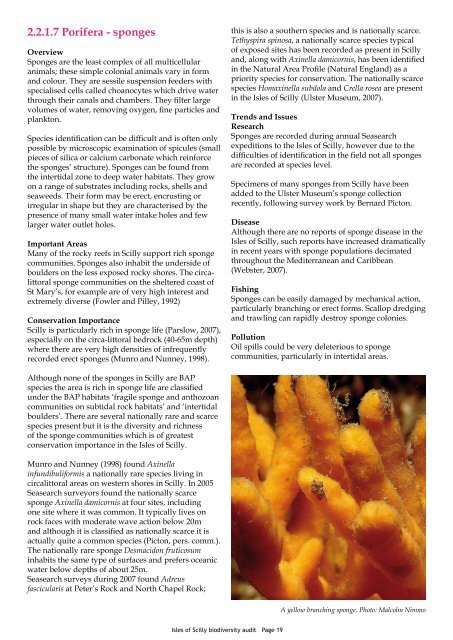The Isles of Scilly Biodiversity Audit 2008 - Cornwall Wildlife Trust
The Isles of Scilly Biodiversity Audit 2008 - Cornwall Wildlife Trust
The Isles of Scilly Biodiversity Audit 2008 - Cornwall Wildlife Trust
You also want an ePaper? Increase the reach of your titles
YUMPU automatically turns print PDFs into web optimized ePapers that Google loves.
2.2.1.7 Porifera - spongesOverviewSponges are the least complex <strong>of</strong> all multicellularanimals; these simple colonial animals vary in formand colour. <strong>The</strong>y are sessile suspension feeders withspecialised cells called choanocytes which drive waterthrough their canals and chambers. <strong>The</strong>y filter largevolumes <strong>of</strong> water, removing oxygen, fine particles andplankton.Species identification can be difficult and is <strong>of</strong>ten onlypossible by microscopic examination <strong>of</strong> spicules (smallpieces <strong>of</strong> silica or calcium carbonate which reinforcethe sponges’ structure). Sponges can be found fromthe intertidal zone to deep water habitats. <strong>The</strong>y growon a range <strong>of</strong> substrates including rocks, shells andseaweeds. <strong>The</strong>ir form may be erect, encrusting orirregular in shape but they are characterised by thepresence <strong>of</strong> many small water intake holes and fewlarger water outlet holes.Important AreasMany <strong>of</strong> the rocky reefs in <strong>Scilly</strong> support rich spongecommunities. Sponges also inhabit the underside <strong>of</strong>boulders on the less exposed rocky shores. <strong>The</strong> circalittoralsponge communities on the sheltered coast <strong>of</strong>St Mary’s, for example are <strong>of</strong> very high interest andextremely diverse (Fowler and Pilley, 1992)Conservation Importance<strong>Scilly</strong> is particularly rich in sponge life (Parslow, 2007),especially on the circa-littoral bedrock (40-65m depth)where there are very high densities <strong>of</strong> infrequentlyrecorded erect sponges (Munro and Nunney, 1998).this is also a southern species and is nationally scarce.Tethyspira spinosa, a nationally scarce species typical<strong>of</strong> exposed sites has been recorded as present in <strong>Scilly</strong>and, along with Axinella damicornis, has been identifiedin the Natural Area Pr<strong>of</strong>ile (Natural England) as apriority species for conservation. <strong>The</strong> nationally scarcespecies Homaxinella subdola and Crella rosea are presentin the <strong>Isles</strong> <strong>of</strong> <strong>Scilly</strong> (Ulster Museum, 2007).Trends and IssuesResearchSponges are recorded during annual Seasearchexpeditions to the <strong>Isles</strong> <strong>of</strong> <strong>Scilly</strong>, however due to thedifficulties <strong>of</strong> identification in the field not all spongesare recorded at species level.Specimens <strong>of</strong> many sponges from <strong>Scilly</strong> have beenadded to the Ulster Museum’s sponge collectionrecently, following survey work by Bernard Picton.DiseaseAlthough there are no reports <strong>of</strong> sponge disease in the<strong>Isles</strong> <strong>of</strong> <strong>Scilly</strong>, such reports have increased dramaticallyin recent years with sponge populations decimatedthroughout the Mediterranean and Caribbean(Webster, 2007).FishingSponges can be easily damaged by mechanical action,particularly branching or erect forms. Scallop dredgingand trawling can rapidly destroy sponge colonies.PollutionOil spills could be very deleterious to spongecommunities, particularly in intertidal areas.Although none <strong>of</strong> the sponges in <strong>Scilly</strong> are BAPspecies the area is rich in sponge life are classifiedunder the BAP habitats ‘fragile sponge and anthozoancommunities on subtidal rock habitats’ and ‘intertidalboulders’. <strong>The</strong>re are several nationally rare and scarcespecies present but it is the diversity and richness<strong>of</strong> the sponge communities which is <strong>of</strong> greatestconservation importance in the <strong>Isles</strong> <strong>of</strong> <strong>Scilly</strong>.Munro and Nunney (1998) found Axinellainfundibuliformis a nationally rare species living incircalittoral areas on western shores in <strong>Scilly</strong>. In 2005Seasearch surveyors found the nationally scarcesponge Axinella damicornis at four sites, includingone site where it was common. It typically lives onrock faces with moderate wave action below 20mand although it is classified as nationally scarce it isactually quite a common species (Picton, pers. comm.).<strong>The</strong> nationally rare sponge Desmacidon fruticosuminhabits the same type <strong>of</strong> surfaces and prefers oceanicwater below depths <strong>of</strong> about 25m.Seasearch surveys during 2007 found Adreusfascicularis at Peter’s Rock and North Chapel Rock;A yellow branching sponge. Photo: Malcolm Nimmo<strong>Isles</strong> <strong>of</strong> <strong>Scilly</strong> biodiversity audit Page 19
















